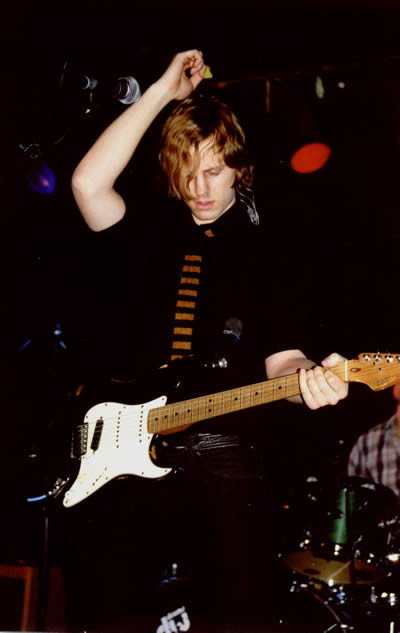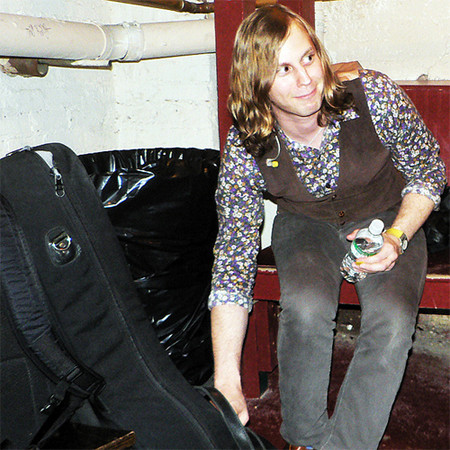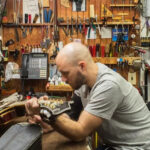
Jared Scharff has packed a remarkable array of experiences into his career in music. From navigating the complexities of a major record label deal early on to becoming a sought-after session musician in the studio, and ultimately landing his coveted role with the Saturday Night Live band, Scharff’s journey is a testament to focus, professionalism, and unwavering optimism. His story offers a compelling look into the life of a modern guitarist who has seamlessly blended diverse musical worlds, making him a prominent figure in the realm of contemporary guitar playing and a notable Snl Guitar Player.
Your early days included studying music at NYU and achieving a major label deal with your band Carbondale on RCA Records. Can you share what that experience was like and the key lessons you took away from it?
That period was truly eye-opening, offering a stark look into the inner workings of the music industry. Witnessing the journey from an unsigned band hustling in the scene to reaching a point of being signed was fascinating in itself. We went through label showcases, the extravagant experience of recording a major label album – which, no exaggeration, cost around $500,000 – navigating changes with three different label presidents, touring and performing to often empty rooms, and the internal band dynamics and conflicts, ultimately leading to being dropped. The entire process was an intense learning curve. It instilled in me valuable lessons about how I wanted to approach the business side of music moving forward. It definitely humbled me and provided a much wiser perspective on the music industry, shaping my future decisions and career path as a professional musician and snl guitar player.
Following Carbondale, you ventured into solo work and formed The Royals. Can you tell us about that transition, and is The Royals still active?
Yes and no, in a way. After Carbondale, I initially started focusing on writing and recording solo material. I took on the challenge of playing every instrument on those recordings, fulfilling a long-held dream of mine. I was inspired by artists like Dave Grohl and Paul McCartney, who demonstrated the ability to create complete musical works independently. This solo work generated some buzz within the New York City music scene, which then led to the formation of The Royals. We were active and performing for a few years, gaining momentum. However, once I landed the SNL guitar player gig, my availability and focus shifted, and The Royals naturally started to slow down. We are no longer performing together as The Royals, but it’s worth noting that everyone from that band has continued to pursue music and is now playing in bands signed to major labels. So, while The Royals may have run its course, it served as a launchpad for all of us to continue our musical journeys in significant ways.
Who are some of the guitarists and musicians who have significantly influenced your style, and what aspects of their playing drew you to them?
My musical influences have been constantly evolving as my personal tastes have expanded and changed over time. It began with an initial phase heavily influenced by Kirk Hammett from Metallica during my early guitar playing days. This progressed into the grunge era, where I was drawn to bands like Pearl Jam and Smashing Pumpkins. Then came my deep dive into classic rock and blues, which was probably the most formative and influential period. During this time, I immersed myself in the playing of guitarists like Eric Clapton, Jimi Hendrix, Stevie Ray Vaughan (SRV), and Warren Haynes. Moving forward, I discovered Johnny Greenwood of Radiohead and Bill Frisell, and eventually broadened my scope to encompass a more general rock and pop style of guitar playing. All of these musicians, in their own unique ways, have significantly shaped my sound and overall style as a guitarist. I consider myself a versatile player, comfortable across many different genres, and these influences are a big part of that.
Each of these players drew me in for specific aspects of their artistry. For instance, Clapton, to me, was the epitome of making a guitar sing with just a single note, conveying immense emotion and melody with incredible phrasing. Hendrix, on the other hand, inspired me with his boundless creativity in sound and sheer intensity and ferocity of his playing. Frisell captivated me with his delicate touch and ability to create gorgeous, atmospheric soundscapes. Johnny Greenwood stood out for his incredibly fresh and innovative part writing within a rock format and his inventive use of guitar pedals. SRV was a master of blues chops, phrasing, and raw intensity. I essentially absorbed these distinct traits and techniques from each of these guitarists, filtering them through my own musical sensibilities to form my personal style as a snl guitar player.
Could you name three albums that you would consider your desert island discs, albums you could listen to endlessly?
If I were stranded on a desert island and could only bring three CDs, I would choose Sigur Ros “( )”, Bill Frisell “Good Dog, Happy Man”, and Jimi Hendrix “Electric Ladyland”. These albums represent a diverse range of musical landscapes and offer endless replay value for me.
How did the opportunity to become the snl guitar player for Saturday Night Live come about?
The SNL gig came about through a recommendation. I was fortunate enough to be recommended by the previous guitarist for the show. Following that, I went through an audition process, playing alongside many other talented guitarists in front of the bandleader, Lenny Pickett. After the initial audition, I received a call back, where I then played with the entire rhythm section of the SNL house band. Shortly after that second audition, I got the call offering me the position. It was a somewhat whirlwind process, but incredibly exciting and a dream come true to become the snl guitar player for such an iconic show.

Can you describe your typical week, and how much direction does Lenny Pickett provide regarding the music you’ll be playing for each week’s SNL show?
My typical week is quite varied and busy. A significant portion of my time is dedicated to working on songwriting and production with my production team, “theSinglesClub,” in New York, and my writing team, “The Sophomores,” when I’m in Los Angeles. We primarily focus on Top 40-style music, collaborating with various major label artists on different projects. Balancing this with my SNL commitments, I usually arrive on Saturday morning for an 11 am rehearsal with the SNL house band.
Regarding musical direction for SNL, Lenny Pickett, the bandleader, is fantastic. He typically provides a clear outline of the musical requirements for the week’s show. This includes charts and specific instructions for the various sketches and musical performances. The level of detail can vary depending on the complexity of the week’s show and the musical guests. However, Lenny and the entire SNL band are incredibly professional and efficient, making the process smooth and collaborative. As the snl guitar player, I need to be prepared to cover a wide range of musical styles and adapt quickly to any changes or requests during rehearsals and the live show.
In the SNL band setting, you’re required to effectively produce a wide array of different guitar sounds. What does your pedalboard setup look like these days to achieve this versatility?
I am really excited about my current pedalboard setup for SNL. I’ve carefully curated a collection of pedals that allows me to cover a vast sonic landscape, which is essential for the diverse musical demands of the show. I’m currently using a Pedaltrain 2 pedalboard, which houses a selection of boutique pedals from makers like Analog Man, Keeley, Xotic Effects, Jon Cusack, SweetSound, Real McCoy, TRex, and Home Brew Electronics. I’ve opted for pedals that are versatile and reliable, rather than anything too esoteric, as the material we play on SNL is generally more direct and straight-ahead. My board includes essential effects like an ultravibe, tremolo, wah, distortion, booster, delay, chorus, and fuzz. These cover the core sounds I need as the snl guitar player.
For amplification, I primarily use my 65amps Monterey as a two-channel amp. This amp is incredibly versatile and forms the foundation of my guitar sound for the majority of the show. The combination of the carefully chosen pedals and the 65amps Monterey gives me the flexibility to quickly switch between different tones and styles, ensuring I can meet the varied musical requirements of each SNL episode.
You recently performed at the Rainforest benefit as part of the house band. What was that experience like, playing alongside such legendary musicians?
Playing at the Rainforest benefit was an absolutely surreal and incredible experience! I honestly never imagined I would find myself in a situation where I was performing at Carnegie Hall with such iconic artists as Sting, Elton John, Bruce Springsteen, Debbie Harry, Lady Gaga, and Shirley Bassey. The house band assembled for that gig was also a dream lineup of musicians. I was seated next to Nile Rodgers in the guitar chair, which was a thrill in itself. I had the chance to spend some time with Sting, and he is a genuinely great person. One of the standout moments was getting to play “Dancing in the Dark” with Bruce Springsteen and interacting with him on a musical peer level. It was pretty amazing to share the stage with such legends. I’m still buzzing from the excitement of that whole experience! It was a career highlight and a testament to the unexpected and incredible opportunities that can arise as a professional musician and snl guitar player.
Are you primarily a single-coil pickup type of guitarist? I’ve noticed you often play Stratocasters and Telecasters on the show. What are some of your preferred guitars?
Yes, I definitely lean towards single-coil pickups. I just love their clarity, articulation, and overall tone. You’re right, I frequently play Stratocasters and Telecasters on SNL. Specifically, I use a Fano JM6 and a Strat – sometimes a Nash, sometimes a Fender, depending on the specific tonal needs of the sketches or musical performances. I also have a James Trussart Telecaster at the SNL studio as well. For my personal use at home and in the recording studio, I mostly use a Stratocaster and my KLH Telecaster. While I do appreciate the sound of humbucker pickups as well, I don’t currently own any guitars with humbuckers… but that’s something I plan to rectify one day! I wouldn’t consider myself a guitar collector by any means. Up until I got the SNL guitar player gig, I only owned two guitars and would often borrow amps for gigs around NYC. Now, my guitar collection has grown a bit, but they are still quite spread out geographically: I keep three live at the SNL studio, one at my home in NYC, one in LA, and another at a studio in NYC. Among my favorite pieces of gear right now are my Nash Strat, Fano JM6, 65amps Monterey, and my vintage Electro-Harmonix “Memory Man” delay pedal.
What are your thoughts on vintage gear, and is that something you incorporate into your setup?
Absolutely, I am a huge admirer of vintage gear. Owning some vintage guitars one day is definitely a dream of mine, although I don’t have any in my current collection yet. Ideally, I’d love to acquire a substantial collection of vintage instruments. Growing up as a classic rock enthusiast, it’s impossible not to be captivated by the guitars and amps that shaped those iconic recordings and live performances. Gear from that era was simply made to an exceptional standard. There’s truly nothing quite like the sound of a vintage amp and guitar. Nothing compares to that classic, timeless tone.


